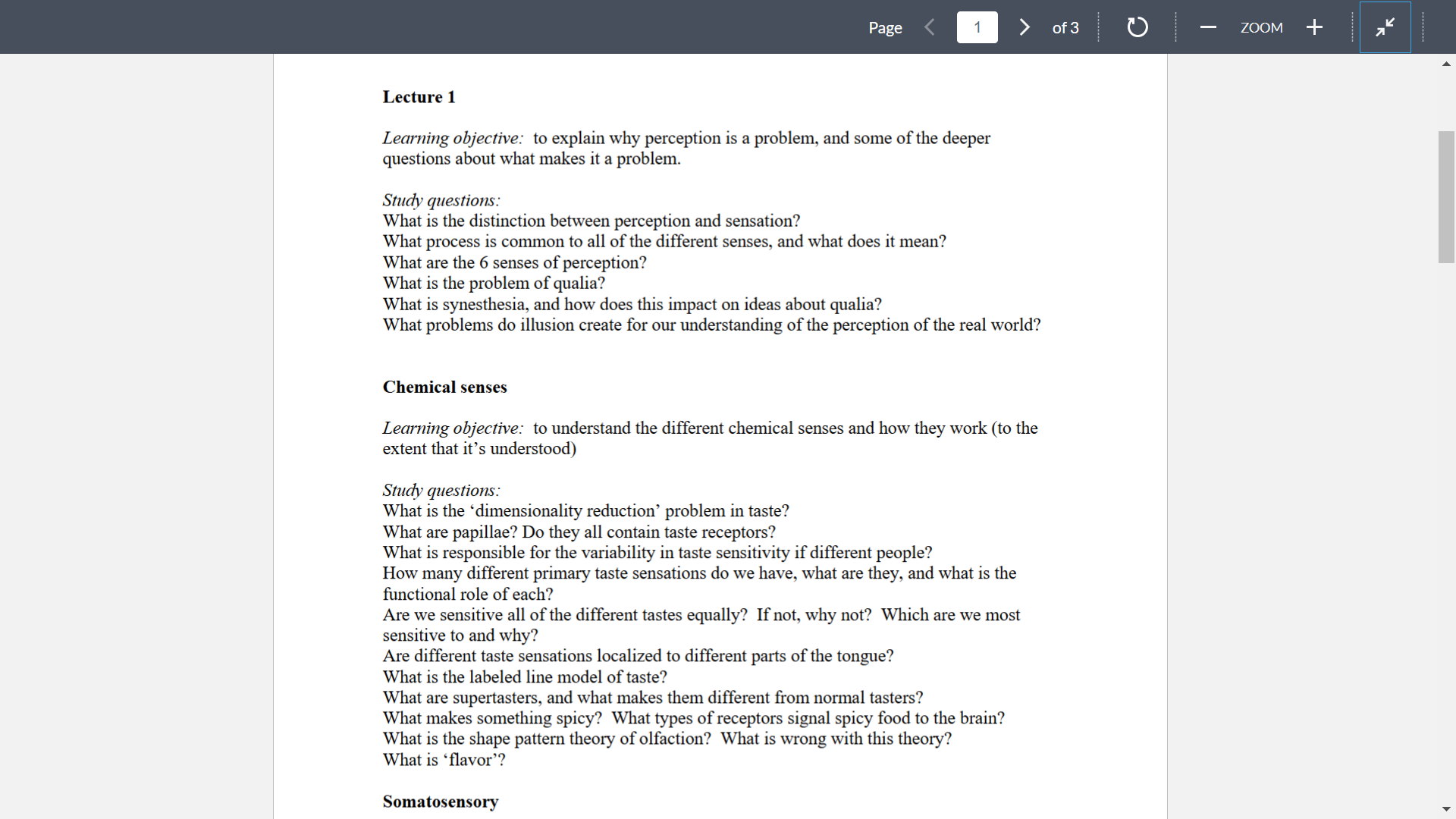What is the distinction between perception and sensation? What process is common to all the different senses, and what does it mean? What are the 6 senses of perception? What is th... What is the distinction between perception and sensation? What process is common to all the different senses, and what does it mean? What are the 6 senses of perception? What is the problem of qualia? What is synesthesia, and how does this impact on ideas about qualia? What problems do illusion create for our understanding of the perception of the real world? What is the 'dimensionality reduction' problem in taste? What are papillae? Do they all contain taste receptors? What is responsible for the variability in taste sensitivity if different people? How many different primary taste sensations do we have, what are they, and what is the functional role of each? Are we sensitive all of the different tastes equally? If not, why not? Which are we most sensitive to and why? Are different taste sensations localized to different parts of the tongue? What is the labeled line model of taste? What are supertasters, and what makes them different from normal tasters? What makes something spicy? What types of receptors signal spicy food to the brain? What is the shape pattern theory of olfaction? What is wrong with this theory? What is 'flavor'?

Understand the Problem
The question presents a series of study questions related to perception and chemical senses. It is asking for an explanation of various concepts related to sensory perception and how different types of senses function.
Answer
Perception interprets sensations from the senses. Common process: transduction. Six senses: sight, hearing, touch, taste, smell, balance. Qualia: subjective experience issues. Synesthesia challenges qualia. Illusions show perception-reality gaps. Papillae vary in taste receptors. Five tastes: sweet, sour, salty, bitter, umami. Sensitivity varies, most sensitive to bitter.
The distinction between perception and sensation is that sensation is the process of sensing through sensory receptors, while perception involves the interpretation and understanding of these sensations by the brain. The common process across all senses is transduction, which converts external stimuli into neural signals. The six senses of perception include sight, hearing, touch, taste, smell, and balance. The problem of qualia involves the subjective experience of perception, as it raises questions about how and if we can understand each other's experiences. Synesthesia, where stimulation of one sensory pathway leads to experiences in another, challenges ideas about qualia by showing interconnected neural pathways. Illusions demonstrate that perception doesn't always align with reality and highlight the brain's interpretative role. The 'dimensionality reduction' problem in taste involves simplifying the complex range of taste signals into basic percepts. Papillae are structures on the tongue; some contain taste receptors while others serve mechanical roles. Variability in taste sensitivity can be attributed to genetic differences, such as the number of taste buds. There are five primary taste sensations: sweet, sour, salty, bitter, and umami, each serving distinct physiological purposes. Humans are most sensitive to bitter, as this taste is often associated with toxins. Taste sensations are not strictly localized to different parts of the tongue; the labeled line model suggests specific receptors correlate to distinct taste perceptions. Supertasters have more taste papillae, making them more sensitive to flavors. Spiciness is sensed by pain receptors (not taste receptors) responding to capsaicin. The shape pattern theory of olfaction suggests odors are detected by receptors matching the odor molecule's shape, but it fails to explain all olfactory experiences. Flavor is the integrated perception of taste and smell.
Answer for screen readers
The distinction between perception and sensation is that sensation is the process of sensing through sensory receptors, while perception involves the interpretation and understanding of these sensations by the brain. The common process across all senses is transduction, which converts external stimuli into neural signals. The six senses of perception include sight, hearing, touch, taste, smell, and balance. The problem of qualia involves the subjective experience of perception, as it raises questions about how and if we can understand each other's experiences. Synesthesia, where stimulation of one sensory pathway leads to experiences in another, challenges ideas about qualia by showing interconnected neural pathways. Illusions demonstrate that perception doesn't always align with reality and highlight the brain's interpretative role. The 'dimensionality reduction' problem in taste involves simplifying the complex range of taste signals into basic percepts. Papillae are structures on the tongue; some contain taste receptors while others serve mechanical roles. Variability in taste sensitivity can be attributed to genetic differences, such as the number of taste buds. There are five primary taste sensations: sweet, sour, salty, bitter, and umami, each serving distinct physiological purposes. Humans are most sensitive to bitter, as this taste is often associated with toxins. Taste sensations are not strictly localized to different parts of the tongue; the labeled line model suggests specific receptors correlate to distinct taste perceptions. Supertasters have more taste papillae, making them more sensitive to flavors. Spiciness is sensed by pain receptors (not taste receptors) responding to capsaicin. The shape pattern theory of olfaction suggests odors are detected by receptors matching the odor molecule's shape, but it fails to explain all olfactory experiences. Flavor is the integrated perception of taste and smell.
More Information
Understanding perception and sensation provides insights into how we interpret the world, how sensory data is processed, and how subjective experiences are formed. Illusions and synesthesia help investigate the complexity of sensory integration.
Tips
Mixing up sensation and perception can lead to misunderstandings. Remember, sensation is about the raw data input, while perception is the meaningful interpretation.
Sources
- Sensation and Perception | Introduction to Psychology - courses.lumenlearning.com
- Noba Project - Sensation and Perception - nobaproject.com
- Sensation vs Perception Explanation - opentext.wsu.edu
AI-generated content may contain errors. Please verify critical information